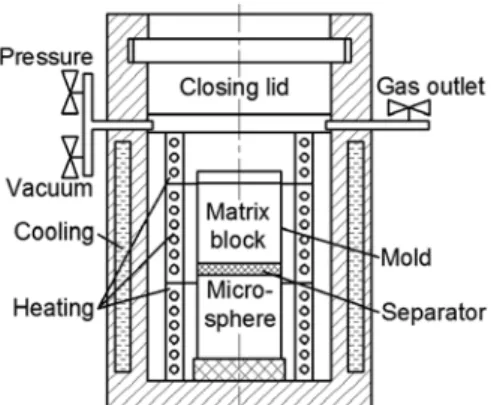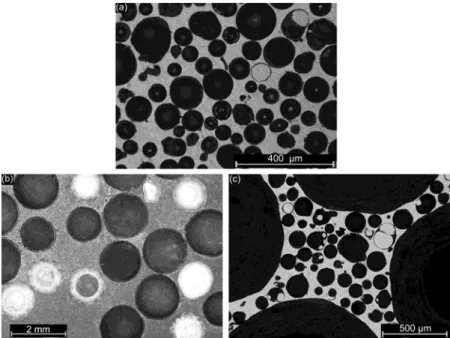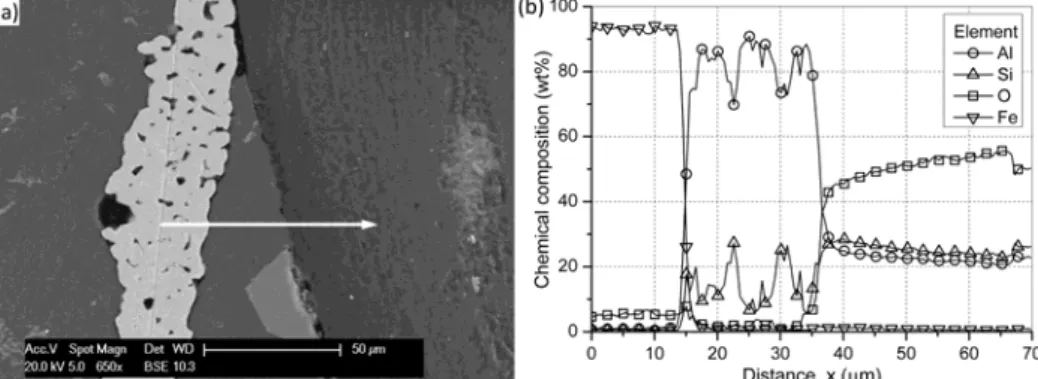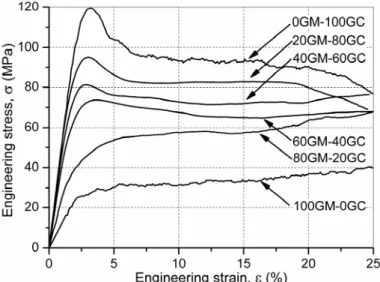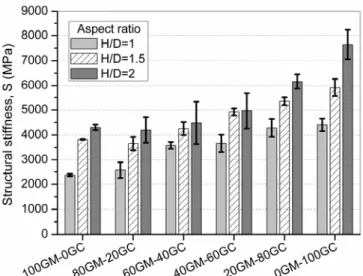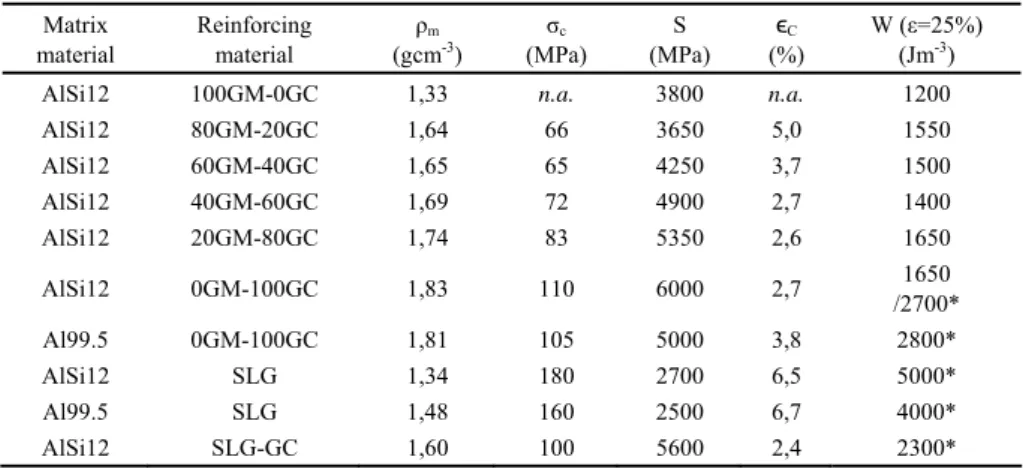Development and evaluation of hybrid aluminium matrix syntactic foams
Kornél MÁJLINGER1,2 , Imre Norbert ORBULOV1,3
1Department of Materials Science and Engineering, Budapest University of Technology and Economics
2Institute of Engineering Sciences, College of Dunaújváros,
3MTA–BME Research Group for Composite Science and Technology
Abstract
A special class of metallic foams, the so called metal matrix syntactic foams was produced by pressure infiltration technique. Metal matrix syntactic foams consist of a light-weight metal matrix and a set of hollow spheres. Microstructural investigations were done on polished specimens. The results showed almost perfect infiltration and thin interface layer between the matrix and the reinforcement. Quasi-static compression tests were also done to get basic information about the mechanical properties of metal matrix syntactic foam. The results showed outstanding mechanical properties among other metallic foams.
The tests were performed in order to prepare pin-on-disc wear tests.
Keywords
metal matrix composite, aluminium matrix syntactic foam, hybrid composite, compressive behavior, wear
1. Introduction
Metal matrix syntactic foams are particle reinforced composites that consist of light-metal matrix and hollow sphere particles. Metal matrix syntactic foams have outstanding mechanical properties among metallic foams. Their compressive strength and plateau strength are extremely high compared to
‘conventional’ metallic foams. They have significant damage localizing properties and due to this can bear high amount of mechanical energy during plastic deformation. The capability to absorb significant mechanical properties makes the metal matrix syntactic foams excellent material for collision dampers.
Metal matrix syntactic foams are also promising materials for low-weight structural parts especially in applications were the original parts have high moment of inertia and exposed to sliding wear. Their low density can ensure low moment of inertia (this is energy saving) and the hollow spheres can serve as reservoirs for lubricating media such as different oils and greases (this can increase operation time). The mechanical and microstructural properties of metal matrix syntactic foams have been more or less widely studied and published in
the professional literature; in contrast the wear properties are marginally investigated. Our aim in this paper is to give a short insight into the mechanical properties of metal matrix syntactic foams and to present a basic plan for the future investigation of tribological properties.
2. Experimental
The production of metal matrix syntactic foams
Metal matrix syntactic foams were produced by commercial purity Al99.5 (Al1050) or near eutectic AlSi12 alloy (Al4047) matrices due to their low melting point and low viscosity. The measured chemical composition of the matrix materials were: 0.29 wt% Fe and the remaining was Al for Al99,5, and 12.830 wt% Si, 0.127 wt% Fe, 0.002 wt% Cu, 0.005 wt% Mn, 0.010 wt% Mg, 0.007 wt% Zn and the remaining was Al for the AlSi12 alloy. The compositions were in the range of the standardised nominal values. The total amount of reinforcement was maintained at high level (~64 vol.%) that corresponds to randomly closed packed structure. For reinforcement three grades of hollow spheres were used, two ceramic and one metal. The hollow spheres with larger diameter were manufactured by Hollomet GmbH. The ceramic hollow spheres were manufactured by Envirospheres Ltd.
The ceramic hollow spheres with larger diameter (Globocer, GC) had the average diameter and wall thickness of Ø1450 µm and t=60 µm respectively, while their density was ρ=0.816 gcm-3. The chemical composition of the hollow sphere’s wall material was 33 wt% Al2O3, 48 wt% SiO2 and 19 wt%
3Al2O3·2SiO2.
The ceramic hollow spheres with smaller diameter (E-sphere SLG, SLG) had the average diameter and wall thickness of Ø130 µm and t=6 µm respectively, while their density was ρ=0.637 gcm-3. The chemical composition of the hollow sphere’s wall material was the same as in the case of GC spheres.
The metallic hollow spheres (Globomet, GM) had the similar average diameter but lower wall thickness, while the density was ρ= 0.4 gcm-3. The fracture force of GC and GM grade hollow spheres between polished plates was 22.1±1.18 N and 5.1±0.18 N (50-50 measurements) respectively, so the GC grade hollow spheres proved to be significantly stronger. The GC grade spheres showed brittle fracture while the GM grade hollow spheres proved failure due to large plastic deformation. The ratio of the hollow spheres was varied from 100%
GC and 0% GM to 0% GC and 100% GM, in 20% steps.
The ASFs were produced by inert gas (Ar) assisted pressure infiltration (see Fig. 1).
The hollow spheres were poured into a 360 mm height, graphite coated carbon steel mold (cross section: 40×60 mm) to the half and they were densified by gentle tapping to get randomly close packed spheres (64 vol.%).
Subsequently, a layer of alumina mat separator was placed on the hollow spheres and a block of matrix material was put on the mat. The mold was situated into the infiltration chamber; the furnace was closed and evacuated by a vacuum
pump (rough vacuum). The heating was ensured by three heating zones and the temperatures of the matrix block and the hollow spheres were continuously monitored by two thermocouples. After melting the molten sealed the mold above the separator layer. The vacuum pump was switched off and Ar gas was let into the chamber with a previously set 400 kPa pressure. The pressure difference (400 kPa in the chamber and vacuum under the liquid cork) forced the molten metal to infiltrate into the space between the hollow spheres. After solidification the mold was removed from the chamber and water cooled to room temperature. Then the ASF block (~40×60×180 mm) could be removed from the mould. For further details about the production process please refer to (Orbulov I.N. and K. Májlinger, 2013).
Figure 1. Schematic sketch of the infiltration chamber
Two kinds of hybrid composite blocks were produced: (I) with two different reinforcement material but with the same hollow sphere size range (GM and GC), (II) with pure ceramic reinforcement but very different size range (SLG and GC).
In the first case the blocks were designated after their constituents: e. g. 80GM- 20GC stands for an ASF block with ~64 vol.% of hollow spheres that is mixed from 80 vol.% GM and 20 vol.% GC grade hollow spheres. In the second case the blocks were also designated after their constituents but without the number for volume fraction. The measured densities (ρm) of the blocks, determined by Archimedes’ method, are listed in Table 1. The produced ASF blocks to be investigated and the main mechanical properties are also listed in Table 1.
Investigations of the syntactic foams
Scanning electron microscopy (SEM) investigations and energy dispersive X-ray spectroscopy (EDS) along lines were performed by a Phillips XL-30 type electron microscope equipped with an EDAX Genesis EDS analyzer on metallographically polished surfaces. The measurement started from the matrix materials and crossed the wall of the hollow sphere perpendicularly. Each point was excited for 15 s with 35 µs detector amplification time.
The compressive properties were investigated in quasi-static conditions on cylindrical specimens. The aspect ratio (height to diameter ratio, H/D) of the specimens was varied: the diameter (D) of the specimens was 14 mm and the height (H) of the specimens was 14, 21 or 28 mm (H/D 1, 1.5 and 2 respectively). The compression tests were performed on a MTS 810 type universal testing machine in a four column tool with polished surface at room temperature. The specimens and the tool were lubricated with Locktite anti-seize material. The strain rate was 0.01 s-1. Five specimens were compressed from each specimen group up to 25% engineering strain to get representative results and to verify repeatability. The results were evaluated according to the standard (DIN50134) about the compression tests of cellular materials and the characterizing properties (compressive and yield strength, fracture strain, structural stiffness and absorbed energies) were monitored.
3. Results and discussion
The microstructure of the syntactic foams
First the microstructure of the ASFs was analyzed from the point of view of pressure infiltration (see Fig. 2). The ceramic and the metal hollow spheres can be easily separated in the photos. The micrographs show almost perfect infiltration, the smallest cavities between the hollow spheres were fulfilled completely by the matrix materials. The uninfiltrated void content between the hollow spheres remained well below 3% for all the ASFs.
Figure 2. Micrographs of typical areas in the ASFs (a) Al99.5-SLG, (b) AlSi12-80GM-20GC, (c) AlSi12-SLG-GC
Some broken and therefore filled hollow spheres can be observed in Fig. 2a and c, which can occur if the hollow sphere brakes during the infiltration or if it has already broken before the infiltration. In most cases the broken spheres were GM grade, because the molten AlSi12 – as chemically aggressive medium – can dissolve pure Fe from the wall and it can leads to the breakage and infiltration of the hollow spheres. In the case of ceramic hollow sphere the Al content of the matrix could dissolve Si from the wall of the spheres.
The other important point of view is the interface layer between the reinforcement and the matrix material. This layer is responsible for the proper load transfer between the constituents and therefore has determinative effect on the mechanical properties. In the case of ceramic hollow sphere the Al content of the matrix could dissolve Si from the wall of the spheres according to Eq. 1.
4Al(liq.)+3SiO(sol.)Æ2Al2O3(sol..)+3SiO(sol.) (1)
This diffusion reaction is induced by the Si concentration mismatch between the material of the hollow spheres and the matrix. However, this exchange reaction is suppressed by the high Si amount in the matrix. The presence and thickness of the interface layer between the constituents has been investigated by line EDS analysis. A typical site of AlSi12-40GM-60GC ASF is shown in Fig.
3. The SEM micrograph of a GM (left) and GC (right) hollow spheres near to each other and the path of the line EDS analysis (arrow) are shown in Fig. 3a, while the chemical composition along the investigated line is plotted in Fig. 3b.
Figure 3. BSE image (a) of a GM (left) and a GC (right) grade hollow sphere and EDS line-scan profile (b) of AlSi12-40GM-60GC ASF
The SEM micrograph also confirms the perfect infiltration: the less than 10 µm gap between the GM and GC grade hollow sphere is completely fulfilled.
The chemical composition along the path of the analysis changes according to the composition of the wall and the matrix materials. The first few microns were measured in the GM grade hollow sphere and shows mainly Fe and some O due to the slight oxidization of the surface. Between the spheres the Al and Si
content is dominant, but Si peaks can be also observed due to the near eutectic composition of the matrix material. In the GC grade hollow spheres the Al-Si-O ratio set to the corresponding constitution of the ceramic wall material. In the interface layers between the GM and GC hollow spheres and the matrix material sudden changes can be observed in the chemical composition. These short transient zones indicate thin interface layers. The thickness of the layers can be estimated from the slope changes of the differentiated Fe and O curves and by the AlSi12 matrix it was 7 µm, 5 µm and 5 µm in the case of GM, GC and SLG hollow spheres respectively. For the Al99.5 matrix alloy the thickness of the interface layers due to the lower Si content were about 1-2 µm thicker, but for all the samples it remained under 10 µm.
The compressive behavior of the syntactic foams
Typical compressive stress-strain curves of the series of the GM-GC ASFs with H/D=1 are shown in Fig. 4, the amount of GC hollow sphere content improved the mechanical properties significantly. In Fig. 5 the structural stiffness values (S, the initial slope of the stress – strain curves) can be observed. It is clear that the mechanical properties are also dependent on the specimen’s height to diameter aspect ratio. For our samples general the following dependence of H/D ratio can be made: the structural stiffness values increase with higher H/D ratio, all the other important mechanical properties like compressive strength (σc, the first stress peak of the stress – strain curve), yield strength (σy, at ε=1%), fracture strain (εc, at σc), and absorbed energy (W) values decrease with the higher H/D ratio. The main mechanical properties for the investigated ASF’s (H/D=1.5) are listed in Table 1.
Figure 4. Typical engineering stress – engineering strain curves of GM-GC hybrid ASFs (H/D=1)
Figure 5. The structural stiffness of GM-GC hybrid ASFs as the function of hollow sphere grade and aspect ratio
GM-GC hybrid ASFs: The compressive strength increased with the amount of GC reinforcement. The gradient of the latter increment was constant and moderate in the case of these ASFs. As the amount of the weaker, plastically deformable GM fraction decreased, the compressive strength increased. In the case of pure GC reinforcement a higher increment can be observed: the stronger GC hollow spheres and the lack of plastically deformable GM hollow spheres ensured higher strength levels. In Fig. 4 the comparison of the curves confirms this trend. The ASFs with pure GM grade reinforcement behave like conventional metallic foams. They had no pronounced compressive strength, but a long, slowly increasing plateau region and completely plastic deformation. In the case of pure GM reinforcement, pronounced compressive strength cannot be determined. As the amount of the GC hollow spheres increased the pronounced compressive strength became more and more emphasized. As the amount of the GC hollow spheres increases, the fracture strain decreases and the failure mode became brittle. The total absorbed mechanical energies had a local minimum in the case of 40GM-60GC reinforcement.
SLG-GC hybrid ASFs: To determine the effect of the sphere size, ASFs were made with pure SLG or GC reinforcement, and also hybrid ASF were produced with SLG and GC reinforcement. ASFs with SLG reinforcement had
~40% higher compressive strength and fracture strain, but ~50% less structure stiffness than the ASFs reinforced with GC hollow spheres. ASFs with SLG and GC reinforcement had about the same compressive properties than those of GC reinforcement, but at lower density.
Effect of matrix material: as it is anticipated ASFs with Al99.5 matrix had higher fracture strain, ASFs with AlSi12 matrix were more brittle but the compressive strength, structural stiffness and total energy values were higher.
Table 1. Main mechanical properties for the ASFs (H/D=1.5)
Matrix material
Reinforcing material
ρm
(gcm-3)
σc
(MPa) S (MPa)
ϵC
(%)
W (ε=25%) (Jm-3) AlSi12 100GM-0GC 1,33 n.a. 3800 n.a. 1200 AlSi12 80GM-20GC 1,64 66 3650 5,0 1550 AlSi12 60GM-40GC 1,65 65 4250 3,7 1500 AlSi12 40GM-60GC 1,69 72 4900 2,7 1400 AlSi12 20GM-80GC 1,74 83 5350 2,6 1650 AlSi12 0GM-100GC 1,83 110 6000 2,7 1650
/2700*
Al99.5 0GM-100GC 1,81 105 5000 3,8 2800*
AlSi12 SLG 1,34 180 2700 6,5 5000*
Al99.5 SLG 1,48 160 2500 6,7 4000*
AlSi12 SLG-GC 1,60 100 5600 2,4 2300*
*corresponds to ε=50%
Future plans for wear test: Several studies on the tribological behaviour of common engineering materials e.g. (Keresztes and Kalácska 2010) and (Zsidai et al., 2002) in contact with steel have been published. But the wear properties of aluminium matrix composites have been studied e.g. (Ramachandra M. and K.
Radhakrishna 2005), but wear properties of ASFs are not widely studied.
Therefore pin-on-disc wear tests are planned to be performed on the specimens listed in Table 1. The investigation of GM-GC hybrid ASFs can give insight to the wear properties of ASFs with different reinforcement in the same size range (with the high strength but brittle ceramic GC and low strength but ductile GM) hollow spheres. The effect of sphere size can be investigated and compared to GC reinforcement by the ASFs with SLG reinforcement. The size of the hollow spheres could have a large influence under lubricated conditions. If ASFs, reinforced with small diameter ceramic hollow spheres are mechanically machined, the hollow spheres will be opened and they can serve as lubricant reservoirs for sliding parts similar to the non-communicating oil reservoirs at laser treated cast iron cylinder blocks (Májlinger and Szabó, 2012). The expected low friction results in lower wear rate, combined with light-weight structure can replace a lot of sliding machine parts like the mentioned cylinder bores in engine blocks. The influence of the matrix material could be also observed by the Al99.5 and AlSi12 specimens. The tests on steel counterparts are planned at 2, 3, 4 ms-1 speed like in (Mondal D.P., et al., 2009)) under dry and lubricated conditions (Jha N. et al., 2011). So called small-scale tests are planned to be used because of the simple test rig with low forces and power, reduced cost for preparing test specimens, easy of control of environment.
Moreover many small-scale results are available in literature to be referenced, e.g. (Zsidai et al., 2004), (Samyn, 2007), (Keresztes et al., 2008).
Conclusions
From the above detailed investigations, the following conclusions can be drawn:
– Pressure infiltration is a convenient method to produce hybrid ASFs with high hollow sphere content and low uninfiltrated porosity.
– Solution of Fe from GM grade spheres into the AlSi12 matrix occurred, that cause damage to the spheres wall and lead in some cases to infiltrated hollow spheres. An exchange reaction between the Al99.5 and AlSi12 matrices and the GC and SLG grade spheres occurred. In the case of AlSi12 matrix this exchange reaction was suppressed by the high Si amount of the matrix alloy. The interface layers proved to be thin; the average layer thickness was less than 10 µm for all the samples.
– In the case of GM-GC hybrid ASFs the compressive strength as well as the structural stiffness were increased, while the fracture strain was decreased as the GC grade hollow sphere fraction increased, respectively.
– In the case of GM-GC hybrid ASFs the absorbed mechanical energies had a local minimum in the case of 40GM-60GC reinforcement. In the case of higher GC content the compressive and the plateau strengths were higher and therefore the absorbed energies became higher. In the case of lower GC content the strengths became lower, but the ductility of GM grade hollow spheres could balance and overcame this effect.
Acknowledgements
This research was supported by the European Union and the State of Hungary, co-financed by the European Social Fund in the framework of TÁMOP 4.2.4.
A/2-11-1-2012-0001 ‘National Excellence Program’.
References
[1] Jha N., A. Badkul, D.P. Mondal, S. Das and M. Singh (2011) Sliding wear behaviour of aluminum syntactic foam: A comparison with Al–10 wt% SiC composites
[2] Keresztes R. and G. Kalácska (2010), Research of machining forces and technological features of cast PA6, POM C and UHMW-PE HD 1000, Sustainable Construction & Design, 1, 136-144.
[3] Keresztes R., G. Kalácska, L. Zsidai and O. Eberst (2008) Abrasive wear of polymer based agricultural machine elements in different soil types, Sereal Research Communications, 36, 903-906.
[4] Májlinger K. and P.J. Szabó (2012), Investigation of the surface of a laser- treated cast iron cylinder bore, International Journal of Materials Research, 103/10, 1223-1227.
[5] Mondal D.P., S. Das, N and Jha (2009), Dry sliding wear behaviour of aluminum syntactic foam, Materials and Design, 30, 2563–2568
[6] Orbulov I.N. and K. Májlinger (2013), Mcrostructural aspects of ceramic hollow microspheres reinforced metal matrix composites, International Journal of Materials Research, 9, 903-911.
[7] Ramachandra M. and K. Radhakrishna (2005), Synthesis-microstructure- mechanical properties-wear and corrosion behavior of an Al-Si (12%) – Flyash metal matrix composite, Journal of Materials Science, 40, 5989–5997.
[8] Samyn P., G. Kalácska, R. Keresztes, L. Zsidai and P. De Baets (2007) , Design of a tribotester for evaluation of polymer components under static and dynamic sliding conditions, Proceedings of the Institution of Mechanical Engineers Part J Journal of Engineering triblogy,221 (J6), 661-674.
[9] Zsidai L., P. De Baets, P. Samyn, G. Kalácska, A.P. Van Peteghem and F.
Van Parys (2002), The tribological behaviour of engineering plastics during sliding friction investigated with small-scale specimens, Wear, 253, 673–688.
[10] Zsidai L., P. Samyn, K. Vercammen, K. Van Acker, M. Kozma, G.
Kalácska and P. De Baets (2004), Friction and thermal effects of engineering plastics sliding against steel and DLN-coated counterfaces, Tribology Letters, 17/2, 269-288.
